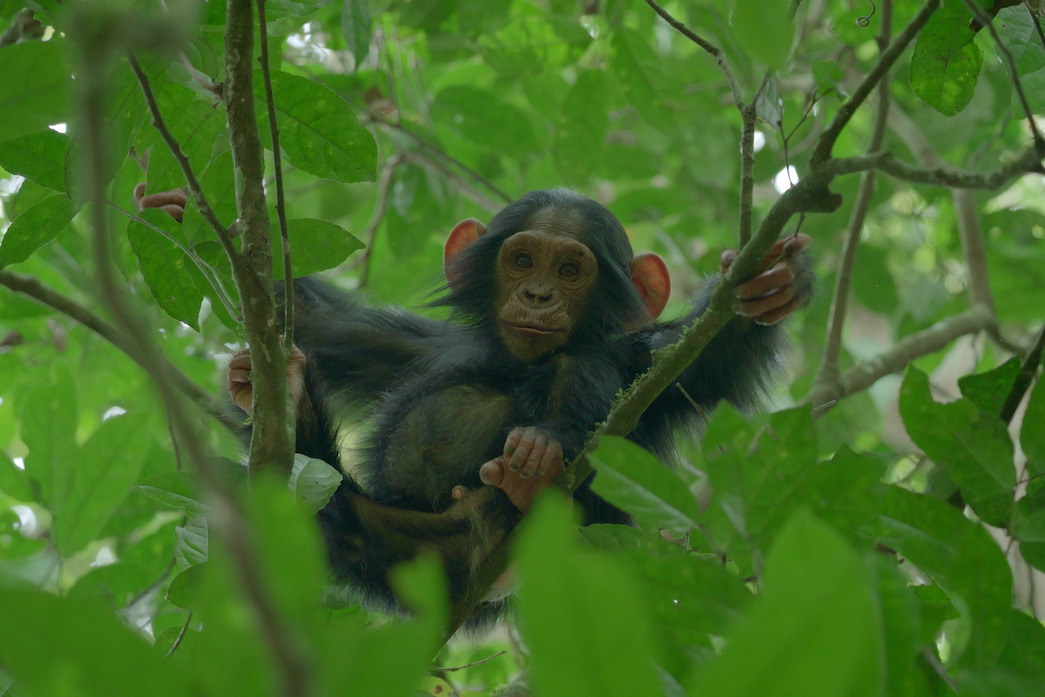A new Netflix documentary provides deep insights into the power struggles, emotions and territorial conflict among chimpanzees living in the Ngogo forest inside Uganda’s Kibale national park.
While it is common knowledge that chimpanzees are closely related to humans (humans and chimps share 98.8 percent of their DNA), the 4-part documentary shares an observatory tale of how these primates live, their social behavior and their survival instincts.
Episode one opens with a chimp tending to her baby. Human-like attributes such as kissing a baby passionately explain how the primates create strong bonds.
Directed by Oscar-winning director, James Reed, the story draws the viewer into the ecosystem in the pristine Kibale national park which is also inhabited by butterflies, beetles, lizards, birds, elephants, baboons, monkeys, and duikers among others.
In Ngogo which is described as “a chimpanzee paradise” due to its vast supply of fruit trees (primary food for chimps), over 120 chimpanzees live together, the biggest group ever discovered, according to the docuseries titled Chimp Empire. Normal groups tend to be between 40 and 50.
Chimp Empire which premiered April 19 is also a window into the politics that characterize chimp groups, the hierarchy in which they are organized and how tactics, alliances and biology influence power. You also learn the things that threaten power and the consequences for elements that threaten the alpha male (the group leader).
ALSO READ: Netflix’s documentary on apes sheds light on Uganda’s Bwindi and Kibale national parks
In one of the groups, ‘Jackson’ a 31-year-old alpha male who has been at the helm for 6 years must tame a 21-year-old male who is defiant and seeks to challenge him. To help the alpha male achieve this is ‘Miles’ (40) who is his protector and right-hand man.
Grooming is a key aspect of chimpanzees’ way of life. Using extensive footage that captures these primates’ mannerisms, the documentary explains how they use grooming to create and maintain relationships. It’s how they communicate and how they forge alliances.
American actor, Mahershala Ali (Moonlight) narrates the docu which uses powerful soundtracks and natural sounds to express emotion, tension and the diversity of wildlife in Kibale.
James Reed who won an Oscar for My Octopus Teacher, another nature documentary, builds on his reputable track of telling compelling stories about nature, to deliver unique storylines about what makes the Ugandan chimps extraordinary.
It isn’t his first story on chimps. He produced and wrote Rise of the Warrior Apes, a 2017 documentary about an extraordinary troop of chimpanzees in Ngogo, Kibale national park, featuring four mighty warriors who rule through moral ambiguity, questionable politics, strategic alliances and destroyed trust.
It is no coincidence that both Rise of the Warrior Chimpanzee and Netflix’s Chimp Empire are set in Uganda’s Ngogo forest.
Ngogo is one of two research sites that the Ugandan government maintains in Kibale national park under the auspices of the Makerere Univeristy Biological Field Station (MUBFS).
In 1972, Thomas Struhsaker, then with the New York Zoological Society, established the Ngogo research area. His primary focus was forest ecology and the behavioral ecology of red colobus monkeys, but he also studied the behavioral ecology of red-tailed monkeys and grey-cheeked mangabeys and the effects of logging.
Since 1995, David Watts (Yale University) and John Mitani (University of Michigan) have been co-directing the Ngogo Chimpanzee Project.
Over the years, many expatriate and Ugandan students, often mentored by Struhsaker, and many independent researchers have studied primate behavioral ecology, forest dynamics, rodent population biology, elephant ecology, and other topics.
As in humans, survival is essential among chimps. Through Chimp Empire, you get to appreciate how survival influences territorial conquests in search of food. After fruits, meat is the next food of choice for chimpanzees. Unknown to many, monkeys are prey to chimps. Episode 1 and 2 of the series shows how chimps hunt, kill and devour black and white colobus monkeys that inhabit Ngogo.
A chimp in the Western Ngogo clan lost his hand to a snare trap set by poachers, a reminder of human-wildlife conflict, the biggest challenge confronting Uganda’s conservation efforts.
Bashir Hangi, the Communications Manager at Uganda Wildlife Authority (UWA) says Chimp Empire is a testament to Uganda’s success story in chimpanzee conservation.
“Before they choose which stories to document, they look at a number of factors. I know they know Uganda’s success story in; chimp conservation, maintaining the integrity of the habitat and the fact that we have a number of chimpanzee families,” Hangi told Plugged.
“We have a research station, so that is a motivation for them (filming crews) to come. Because they would want to interact with researchers to get more information for their scripts and to know more about chimp behavior and the forest.”
Although he says such productions pay a research fee to Uganda, the value of documentaries like Chimp Empire and Rise of the Warrior Chimpanzee go beyond just the monetary benefits. These stories play a role in disseminating research findings and creating interest among those that find these stories compelling and would want to visit Kibale.
“The stories tell the tourism potential of the park. There’s someone who will watch the documentary and say ‘Me I want to go there (Uganda) and see for myself’. Thereby promoting tourism in the park.”
The food chain – who eats whom – within Ngogo is as perplexing as it is elsewhere in the wild. Birds disperse fruit seeds. Seeds grow to become trees. Trees produce fruit which is eaten by monkeys. Monkeys get eaten by chimpanzees. When the chimps die, bacteria break down its body returning it to the soil where it provides nutrients for the tree to grow.
This food chain begs the question – Does the survival of chimps in Ngogo pose an existential threat to monkeys? Hangi says the vermin nature of monkeys makes it difficult to control them and to know the impact the chimps have had on them. He adds that there are no reliable figures on the monkey population since their mobility makes it hard to conduct a census.
“Also, we never interfere with the jungle system. Even if we were the and saw a chimp run after a monkey, we would not save it (monkey) because that’s how things are designed in the wild. It’s their food,” Hangi says.
“But certainly, it negatively affects the population of monkeys because once a monkey is eaten, it’s dead. And that’s one gone.”








